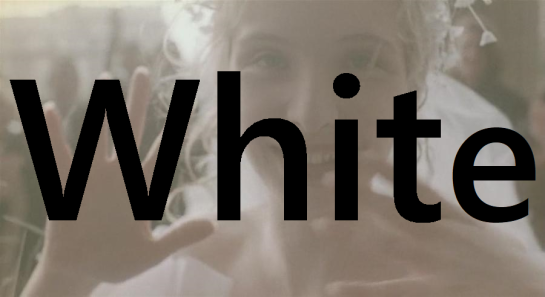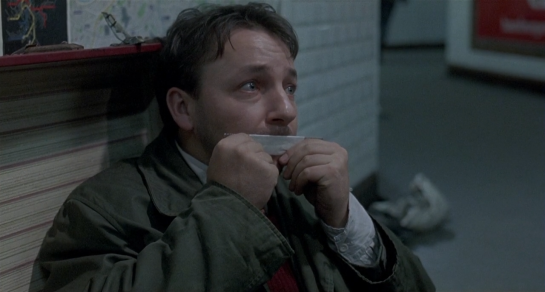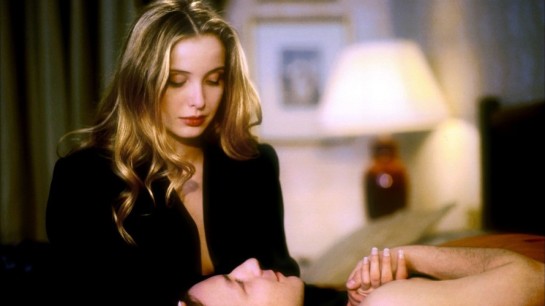
Krzysztof Kieślowski was at a pivotal point in his life while making his renowned Three Colors trilogy. He had determined that these would be his last movies and at the conclusion of his trilogy he announced it to the world. It was 1994 and Kieślowski was at the pinnacle of his career. Yet he stepped away from filmmaking with the intent of sitting at home and smoking while never ever visiting a cinema again. Sadly, Kieślowski would die two years later at the age 54. A true artist driven by his own rules right to the end.
Kieślowski’s Three Colors trilogy couldn’t be a better send off – a testament to a visionary’s passion for creating movies that burrow deep into the human elements that connect us. Kieślowski once said he preferred “touching on subject matters and situations which link people, and not those that divide people.” While he often spoke to the social and political climates of his times, they were too divisive and they were rarely his focus. He later said “Feelings are what link people together.” That very idea permeates ever frame of his Three Colors movies.
The trilogy’s name is taken from the three colors of the French flag – blue, white, and red. Each of the flag’s colors represent a particular ideal. Blue stands for liberty, white for equality, and red for fraternity. Each movie represents one of these ideals but on a human level and never within a political framework. Politics tend to divide and that was of no interest to Kieślowski. He sought to examine these principles within the confines of individual lives and all of the love, sorrow, pain, and humor that comes with living. These are feelings and emotions that we all know and can connect to. All three films, while able to stand on their own, do connect in subtle and sometimes surprising ways.

When writing about “Blue” (the first film in Krzysztof Kieślowski ‘s Three Colors trilogy) I noted the difficulties in first finding the liberty. In “White” recognizing a meaningful connection to “equality” proves even harder, but it is there for the gleaning. All it takes is a careful eye to see it in the central relationship, in the sociopolitical probing, and in viewing the story as one big sweeping allegory. And as with the color blue in the previous film, white is prominently used for a number of purposes.
But at the same time Kieślowski doesn’t seem beyond using the color white to play with his audience. Those who have watched “Blue” will remember the mood and feeling conveyed by the director’s use of that color. Having set up our inquisitive eyes with that film, you can almost sense Kieślowski chuckling as we try to do the same in “White” – as we try to decipher meaning that isn’t always there. It’s an idea seemingly unique to this installment of the trilogy, but also congruent with what is essentially a dark comedy.

You could say “White” is a story about love, not so much through the eyes of a romantic but a realist. The love Kieślowski examines isn’t neat, warm, and bubbly. It’s peculiar, painful, and messy. That messiness is evident in the film’s opening moments as a Polish hairdresser named Karol (Zbigniew Zamachowski) is being humiliated in a Paris divorce court by his wife Dominique (Julie Delpy). She testifies that she no longer loves him and wants a divorce due to his impotency. Through a series of unfortunate mishaps he loses his home, money, and passport.
With no means of getting back to Poland, Karol resorts to panhandling in the Paris metro. There he meets and befriends a fellow Pole Mikołaj (Janusz Gajos) who helps him get back to Warsaw through the most unorthodox of means. Once home he gets his footing and sets out for revenge/equality which in Kieślowski’s film are inseparable. First Karol throws himself into the fledgling capitalist system of post-communist Poland where we hear repeatedly “everything is for sale”. It’s all part of an elaborate plan to get back at Dominique even though it’s abundantly clear that he still loves her.

Zamachowski was instructed to keep Charlie Chaplin’s movies in the back of his mind when acting. Kieślowski’s intent was not to mimic Chaplin but to let his physical language influence Zamachowski’s performance. It works in two ways, first as an sly comedic device but also in portraying Karol as gentle and timid. We particularly see it in the first half of the film where Karol is seen as hapless and directionless. Much like the beat-up suitcase in the opening scene, moving along on an airport conveyor with absolutely no control of where it’s going.
Things get a little zany in the last act of “White”, but appropriately so considering the quirkiness of the story. Yet while this is easily the lightest of the trilogy, “White” clearly has much to say about a host of things pertaining to the human experience. It isn’t as meditative as “Blue” but it plays with just as many themes and delves into numerous facets of Kieślowski’s favorite subject – human nature. That makes it a worthwhile component of the Three Colors experience.
VERDICT – 4 STARS


I can’t read this because of all them foreigners got them funny names. Gave up on the first line.
Sorry you feel that way Claude. You’re missing out.
Your ignorance is disgusting pal.
I know that this film is considered the weakest film of the trilogy but I love it as I enjoyed its humor as well as its view of post-Communist Poland as it kind of made fun of capitalism.
Yep. It’s generally considered the weakest but I think that does it a disservice. I quite like it on several levels. It’s engaging thematically but also it’s a very slick black comedy. Watching it again reminded me of several things I had forgotten.
Its the one film in the trilogy I watched more than once. Mainly for my love and Julie Delpy
I can see why. I’m that way with Red.
Yeah, I’m with Steven…people consider this the lightest, or weakest, but I adore it…and the more I rest on it the more I love it. Blue and Red have the weight of ‘drama’ enveloping them, but there is something to be said about taking these themes and delegating them to comedy and STILL making them sting as sharply.
Excellent review.
Thanks Andrew. You put it well. It’s still just as stinging in its exploration of themes as the other two movies but adds a really effective comedic twist. I think it really works.
Reading the description of this film, I never guessed it would be quirky. (I’ve never seen any trailers. Sometimes I go full Blind with my upcoming Blindspots lol)
I also had no idea that the film’s titles were based on the French flag, so I’m learning a lot here today. Great review!
Thanks so much Brittani. Yep Kieslowski used the ideals represented by the French flag’s colors as inspirations but never literally. He plays with and presents them in the most thought-provoking ways. My review of Red goes up shortly.
Nice review Keith. As I said before, although I love Blue, I narrowly prefer White. There’s definitely a Chaplin-esque beauty that makes the film so thoroughly enjoyable and it reminds me of much of Charlie Kaufman’s own work. I’m hoping to finally watch Red over Thanksgiving weekend and have lofty expectations based on the previous two installments.
Thanks for following along. Really good to hear other input from those who have seen these films. REALLY anxious to get your take on Red. I do agree on White. I think more people should look at it through a slightly different lens. It’s wrong to dismiss it. Kieslowski is doing so many interesting things in this movie and the fact that he manages to get them all to work harmoniously is incredible.